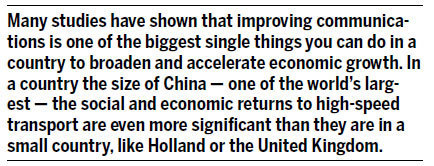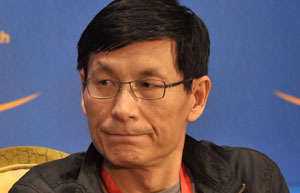Taking China's measure by fast train
By Giles Chance (China Daily) Updated: 2014-10-20 07:29
Many studies have shown that improving communications is one of the biggest single things you can do in a country to broaden and accelerate economic growth. In a country the size of China - one of the world's largest - the social and economic returns to high-speed transport are even more significant than they are in a small country, like the Netherlands or the United Kingdom. Better communications also help to limit or reverse the downside of China's development since 1980, the sharp rise in economic inequality.
We've stopped going uphill and passing through tunnels. Outside the window, there are not many villages. The hills north of Wuhan have stopped and the train is traveling through flat rice-paddies, still at 300 kph. The fields are more orderly, the trees are much taller and there are a lot more of them. The outside temperature in Wuhan is 32 C, according to the electronic monitor in our carriage. Here, the temperature is the same, but sunny and drier. All the Chinese in our carriage are taking their after-lunch nap. Even my wife, who is from Beijing, has her eyes closed. Before she went to sleep, she was telling me about an article she was reading about Chinese Internet development, still dominated by the Big Three (Baidu, Alibaba and Tencent). But, according to the article, that's going to change in the next few years, as Chinese e-commerce expands and the volume of mobile Internet activity mushrooms. While she talks, I think to myself that high-speed trains and mobile Internet are related. They're two areas that have succumbed to the intense pressure of China's demand to develop and modernize. Now China4 is becoming a world leader in both.
Where will this end up, I wonder, as through the window I watch Hebei province become Henan. Where are we going? All we know is that we're on a journey to a world in which many of the 1.3 billion Chinese people don't just become consumers, but world citizens, with passports that take them to New York, Paris, Rio de Janeiro, Cape Town and everywhere else. And, like my train to Beijing, it's happening at 300 kph.
Soon we arrive at Zhengzhou. The rice paddies have been replaced by fields of half-grown grain. Last time I came on this route, in the late 1990s, I could see across the plain for miles. Now, there are lots of trees, holding the dusty soil in its place. By the time we reach Shijiazhuang, the countryside has become populated, with lots of small villages surrounded by well-cultivated fields. It takes 20 minutes to pass through the outskirts and suburbs of Beijing before we arrive at Beijing West Station, right on time at 6 o'clock, eight hours after we left Guangzhou South.
The Guangzhou to Beijing high-speed train is a marvel of engineering and passenger comfort - a high-speed rail line of over 2,294 kilometers, about the same distance as a round-trip journey from Paris to Venice. But, looking out of the window, one can see a China that remains mostly undeveloped. China has come a long way. But it still has far to go.
The author is a visiting professor at Guanghua School of Management, Peking University. The views do not necessarily reflect those of China Daily.
|
 |
 |
| 105-year-old train station bids goodbye | Top 10 high-speed trains in the world |
- China embraced commodity economy in 1984
- Singapore, punching above its weight
- Ramping up R&D investment
- Robust spending keeps growth on track
- Sealed for freshness in orange and blue with a $5.1m target
- Home Credit becomes a leading lender
- Powerful future for investment firm
- Going gets tough for cement companies
















